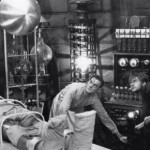
A common misconception of Frankenstein (second to the mistaken belief that Frankenstein is the monster’s name) is that lightning somehow brings Victor’s creature to life. The 1931 movie starring Boris Karloff made the lightning-animation “It’s alive!” scene famous, though in the book Victor plays coy: “I see by your eagerness, and the wonder and hope which your eyes express, my friend, that you expect to be informed of the secret with which I am acquainted; that cannot be: listen patiently until the end of my story, and you will easily perceive why I am reserved upon that subject.”
Regardless, the idea of harnessing nature for power (in addition to controlling the weather for nefarious means) has churned through science fiction for decades. Among others, Asimov writes about channeling and converting the energy of matter, including space itself (presuming it isn’t actually a vacuum) in a process called transduction.
In honor of hurricane Sandy, I thought I’d find out if this could actually happen. Especially out here in Massachusetts where we have enough nifty wind turbines to animate an army of freakishly big green monsters.
Hurricane energy comes in two forms–kinetic wind energy and the energy released when water condenses and forms clouds and/or rain. Scientists calculate that the latter can produce 200 times the amount of energy the entire world can produce in any given moment. A hurricane’s wind energy can release half the amount of energy that the entire world can generate in that same amount of time.
We could all drive Humvees if only we could figure out how to convert hurricane energy!
One of the challenges in harnessing a hurricane’s energy that the storms don’t generally contain concentrated “high grade” energy; instead, they contain “low grade” or diffuse energy.
It’s possible that a big field of wind turbines could work (see?!), but they’d have to be securely anchored in place and be strong enough to avoid damage while retaining full mobility. And planting a field of hurricane wind-converting turbines doesn’t make much sense, as winds this strong don’t tend to frequently recur in the exact same spot–at least not yet. We’ll see what Global Warming has to say about that.
But humans don’t much appreciate being outdone by nature, do they?
In 2005, a Canadian engineer named Louis Michaud proposed generating artificial tornadoes and harnessing their energy for electricity. Conceptually modeled after the solar chimney, the vortex would be created inside a hollow cylinder approximately 200 meters across and 100 meters long positioned inside of a greenhouse, which functions like an oven. As the sun heats the greenhouse, the hot air is forced up the cylinder, helped along by a turbine (and blasts of steam) at the cylinder’s base. The constant rise of hot air and its subsequent expansion, cooling, and condensation would churn the winds until they reached hurricane-size. Ideally, a self-sustaining “atmospheric engine” could be controlled by a fairly small station and could consistently produce 200 megawatts of power.
One possible problem is that meteorological peculiarities could cause the induced tornadoes to spin out of control and out of containment (that’s a plot I’m surprised I haven’t seen in a sci-fi movie yet). Thus far, development of a process that would safely generate and harness the energy of a wind vortex has been moving slowly.
What about lightning, then? In a skyscraper competition, a Tesla Research Facility concept called Hydra won an honorable mention. The Hydra concept involves using hydrogen energy and proposes building a skyscraper out of grapheme, a highly conductive carbon-based material, in order to attract lightning and store its energy.
An average lightning bolt can generate roughly 500,000 megawatts of energy (give or take, depending on the size of bolt). While that sounds like a lot, one lightning bolt could keep a 100-watt lightbulb going for roughly two months. A household would need three to four good lightning strikes per month to keep it lit and running.
The University of Florida’s Lightning Research Laboratory has conducted limited lightning channeling experiments, but concluded that while thunderstorms produce an almost nuclear amount of energy, trying to siphon energy from lightning is next to impossible. The idea of a “lightning farm” comprised of multiple lightning-attracting, energy-storing towers has also been considered, but given the amount of lightning necessary and the relative lack of geographical consistency in lightning strikes, this isn’t plausible either.
We may not be able to run our houses or countries on lightning energy, but at least we can use it for time travel–perhaps to the time when the hurricane clean up is done and the lights are back on.

